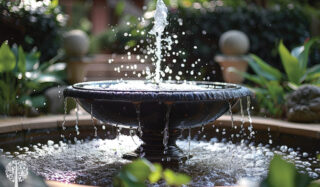How To Sound Map The Garden
Adding sound and mapping the sounds of nature in the garden offers a new perspective to the garden experience.
Sound in the garden is often overlooked. The colorful flowers, the smell of the roses, and the touch of a hosta leaf covered with morning dew are the sensory stars of the garden, not the buzz of a bee as it sucks nectar. And yet, sound can be one of the most beneficial experiences of a garden. A 2021 study, “A synthesis of health benefits of natural sounds and their distribution in natural parks,” examined the health benefits of natural sounds (wind, water, birds, etc.). Researchers discovered that listening to nature’s quiet and subtle sounds improved overall health, decreased stress, improved mood, and enhanced cognitive performance.
Soundscaping and sound mapping the garden can be a lot of fun! You’ll get a brand-new garden perspective, and the whole family can participate!
Sound Map Considerations
Plants
We typically select garden plants for their visual appeal rather than how they contribute to the sound of the space. And yet, they can be very loud. Poppies, cosmos, foxglove, and echinacea form seed heads, reverberating a rattling sound across the landscape. Ornamental grasses swish in the breeze. Bamboo makes a harmonic whistling sound. As rain falls on a hosta leaf, there is a soft crackle and swoosh.
Birds
Our fine feathered friends make a cacophony of sounds. The chickadees call out to each other, the woodpecker taps away, the warble and swallow sing, and the hummingbird’s wings click as it darts from plant to plant for a sweet treat. On hot days, a birdbath that provides water will attract the sound makers. Nesting boxes or birdhouses entice them to move in and stay.


Water
Water is one of the most soothing sounds. A waterfall or fountain creates a burbling sound. And it doesn’t have to be very big. A small tabletop water feature that runs on AA batteries and is placed on the patio can add the right ambiance.


Crunch
Adding a walkway of stone mulch or gravel creates a crunch as you walk. Even the shifting sound of dried grass crumpling under your weight creates sound. One of my favorite garden sounds is the noise fallen leaves make as you walk through them in the fall.
Music
Adding wind chimes throughout the garden creates a musical undertone. Even a cheap spinner makes a musical sound in the wind.


How To Make A Sound Map
Anyone, even the kids, can make a map of all the sounds in the garden. Grab a piece of cardboard big enough to write on, a pen, and mark yourself with a dot in the center of the sheet.
Find a spot in the garden and stand or sit quietly for about five minutes listening. Close your eyes to focus on what you hear instead of what you are seeing. Mark on the card the direction you think the sound is coming from and what it is. It might be leaves blowing in the wind, a bird, or the wind chimes. You’ll be amazed at all the sounds you hear that you might miss while working in the garden.
One of my favorite things to do on a summer afternoon is to sit quietly in the garden and listen! Sometimes, adding a voice to what we see makes it even more real. Adding sound to the garden makes it all that more beautiful and proves it is a living, breathing organism, a diverse ecosystem to be cherished.




